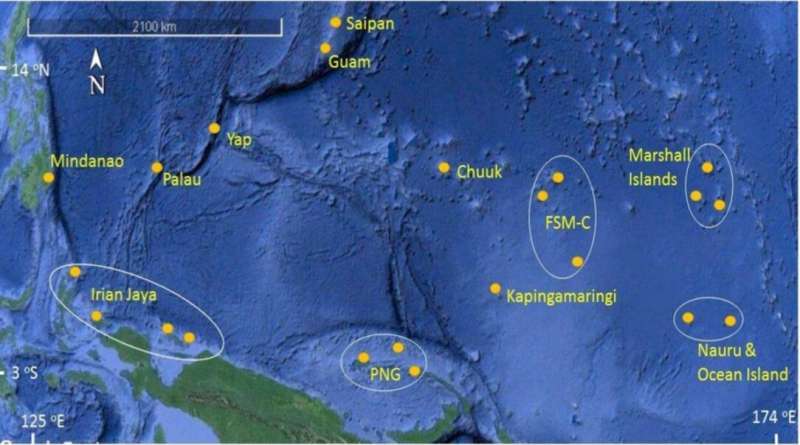Weather, ocean currents key to fish spawning in Micronesia

Larval fish are spawned in a given location and may be recruited into their next life stage—larger, older fish—in the same place or a distant location. The recruitment of rabbitfish in Guam and groupers in Palau has historically been unpredictable. A published study, co-authored by a University of Hawaiʻi at Mānoa School of Ocean and Earth Science and Technology (SOEST) research professor, found that patterns of ocean currents and weather determine the success or failure of recruitment from one spawning event to another in these Micronesian islands.
The team of researchers, including Robert Richmond, research professor and director at the Kewalo Marine Lab in SOEST; Eric Wolanski, James Cook University; and Yimnang Golbuu, Palau International Coral Reef Center, assessed the past 30 years of fish catch information as well as satellite data of ocean currents. They used those data in a high-resolution biophysical model of Guam and Palau to map the fate of fish larvae after spawning. Their model included the consideration of ocean weather and El Niño Southern Oscillation (ENSO), as well as the swimming behavior of mature fish larvae.
Ocean eddies impact fish recruitment
Throughout the years, patterns of recruitment of rabbitfish in Guam and groupers in Palau could not be explained based solely on the impacts of ENSO currents. Rather, the scientists found that ocean circulation patterns caused by huge oceanic eddies were just as important as the ENSO in Micronesia.
"For Guam, the results explained the substantial change from year to year of the rabbitfish catch," said the researchers. "Fish recruitment can be zero after one spawning event and can be extremely high at the next spawning event, depending on both the ocean weather and the ENSO conditions at that time. For Palau, we found that the three spawning grounds of groupers (Ebiil Passage, the Western Passage and the Southwest Passage) were connected, which historically made the Palau grouper population resilient."
Cooperative conservation approach
The researchers also found that up to 99% of the fish larvae are exported from Guam and Palau, hence, these larvae provide key fish population connectivity among the islands of Micronesia. They mapped the patterns of connectivity of grouper fish larvae in Micronesia and discovered that there are two major stocks with high connectivity, one cluster being the island-to-island cluster of Irian Jaya-Palau-Yap-Mindanao, and the other cluster being within the Federated States of Micronesia.
"The likely connectivity of reef fish populations among Micronesian Islands demonstrated by this study supports government efforts at regional cooperation in implementing conservation initiatives and sustainable management of their fisheries," added the researchers. "Most notably of this regional, cooperative approach is the establishment of the Micronesia Challenge, with the different governments in Micronesia coming together and agreeing to effectively conserve their marine resources through a network of marine protected areas, as a legacy for their future generations."
More information: Eric Wolanski et al, Oceanographic chaos and its role in larval self-recruitment and connectivity among fish populations in Micronesia, Estuarine, Coastal and Shelf Science (2021). DOI: 10.1016/j.ecss.2021.107461
Provided by University of Hawaii at Manoa



















